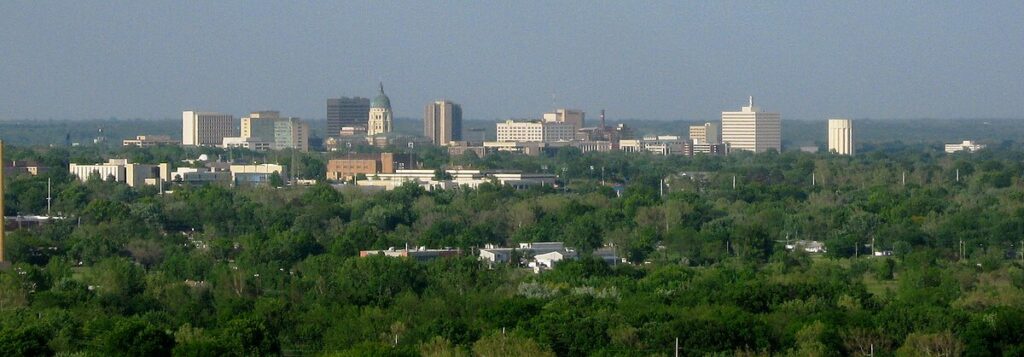
Moving to Topeka, Kansas: A Comprehensive Relocation Guide
Considering moving to Topeka, Kansas? This historic state capital offers government employment, affordable living, and Kansas heritage. With approximately 126,000 residents in 2025 (metro 234,000+), Topeka combines political significance with small-city character and Kansas’ capital city atmosphere.
Demographic Profile to Consider If Moving to Topeka:
Topeka’s 2025 population is approximately 126,000 residents, making it Kansas’ fifth-largest city and state capital, with the metro exceeding 234,000 in Shawnee County. The median age is around 37 years, with government workers, healthcare employees, families, and retirees. The population is approximately 76% White, 11% Black or African American, 8% Hispanic, 3% Asian. Topeka features the Kansas State Capitol complex, historic downtown, Brown v. Board of Education National Historic Site, and serves as the political center. The city attracts state government employees, those seeking Kansas affordability, and families wanting capital city living with small-city character. Topeka appeals to government workers, healthcare professionals, and those prioritizing affordability with employment stability. The community values state capitol status, Brown v. Board civil rights heritage, government employment stability, and maintaining capital city character. Find trusted local services for moving, living, and working in Topeka.Topeka Relocation Directory
Cost of Living to Consider If Moving to Topeka:
Topeka offers exceptional affordability for a state capital. Median home values range from $130,000 to $190,000 in 2025, providing tremendous value with capital city amenities and stable government employment. The median household income is approximately $54,000. Rental properties average $800 to $1,100 monthly. Kansas has no state income tax on Social Security; individual income tax is progressive 3.1%-5.7%. Property taxes are moderate. Overall cost of living is very low for a capital city, making Topeka highly attractive for state employees, working families, and those seeking Kansas affordability with stability. The city provides exceptional value with state government employment providing reliable incomes. Housing costs create accessibility enabling comfortable living on government salaries.
Economy and Job Market:
Topeka’s economy revolves around state government (massive employer with tens of thousands of state workers), healthcare, and services. The State of Kansas government dominates employment across all agencies and departments. Stormont Vail Health and other hospitals provide extensive healthcare jobs. Hill’s Pet Nutrition (Mars Inc.) operates facilities. Goodyear Tire has operations. Typical industries include government, healthcare, manufacturing, and services. The economy provides exceptional stability from state government employment though private sector opportunities are more limited. State government jobs offer benefits and pensions. Many residents accept government employment trade-offs for stability and affordability.
Education:
Topeka Public Schools (USD 501) serves city students with multiple high schools including Topeka High School, Topeka West High School, and Highland Park High School. School quality varies significantly requiring extensive family research. Washburn University offers four-year programs creating some college atmosphere. The educational infrastructure serves the capital city population with schools reflecting working-class character and government employment base.
Recreation and Lifestyle:
Topeka offers Kansas State Capitol providing tours and political atmosphere, Brown v. Board of Education National Historic Site commemorating landmark civil rights case, historic downtown along Kansas Avenue, and the Evel Knievel Museum. Residents enjoy Kansas Museum of History, Combat Air Museum, Topeka Zoo, and Lake Shawnee recreation. The lifestyle emphasizes affordable living, state government employment stability, civil rights heritage, and capital city character. The four-season Kansas climate enables varied activities. The community values state capitol status, Brown v. Board heritage (tremendous pride in civil rights history), government employment (state workers form core community), and affordability. Living in Topeka means accepting geographic isolation (Kansas location, 1 hour to Kansas City), limited cultural offerings beyond capitol/museums, government-dominated economy, and capital city character while enjoying exceptional affordability, stable state government employment with benefits, Brown v. Board historical significance, and Kansas capitol atmosphere enabling comfortable middle-class living where state government meets civil rights heritage and exceptional affordability defines Kansas’ political center.
Healthcare and Services:
Topeka residents access comprehensive healthcare through Stormont Vail Health, Ascension Via Christi St. Francis, and facilities throughout the capital city. The concentration of hospitals serves northeast Kansas as a regional medical hub with quality care.
Transportation:
Topeka is accessed via Interstate 70, U.S. Route 75, Kansas Highway 4 (Kansas Turnpike), and various routes. Topeka Regional Airport provides very limited commercial service. Topeka Metro operates bus service throughout the city. Most residents use personal vehicles. Typical travel times to Kansas City are 1 hour.
Conclusion:
Moving to Topeka in 2025 offers affordable capital city living with state government employment, Brown v. Board heritage, and Kansas character. The city’s combination of exceptionally low housing costs, state government stability, and civil rights history makes it ideal for government workers, families, and those seeking Kansas affordability where state capitol meets Brown v. Board significance and exceptional value defines living in Kansas’ political and civil rights center.

